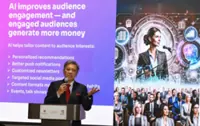Miku performs on stage during a concert at the Zenith concert hall, in Paris, on Jan 16, 2020. Hatsune Miku is part of an expanding group of digital, non-human performers that are attracting the attention of brands and music fans. — AFP
On April 12, Hatsune Miku performed songs on her biggest stage yet – Coachella.
The turquoise-haired Japanese icon has been touring North America, singing to thousands of fans in large concert venues. She’s inked branding deals over the years with companies including Google. And on April 12, she was slated to thrill her followers at one of the world’s biggest music festivals – on the same day as Lana Del Rey and the Deftones.





